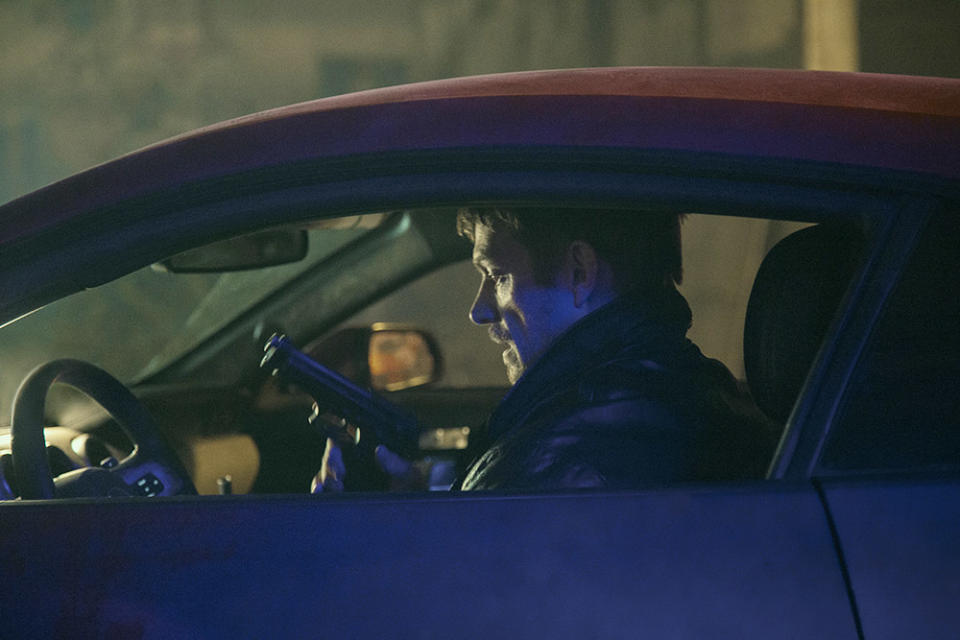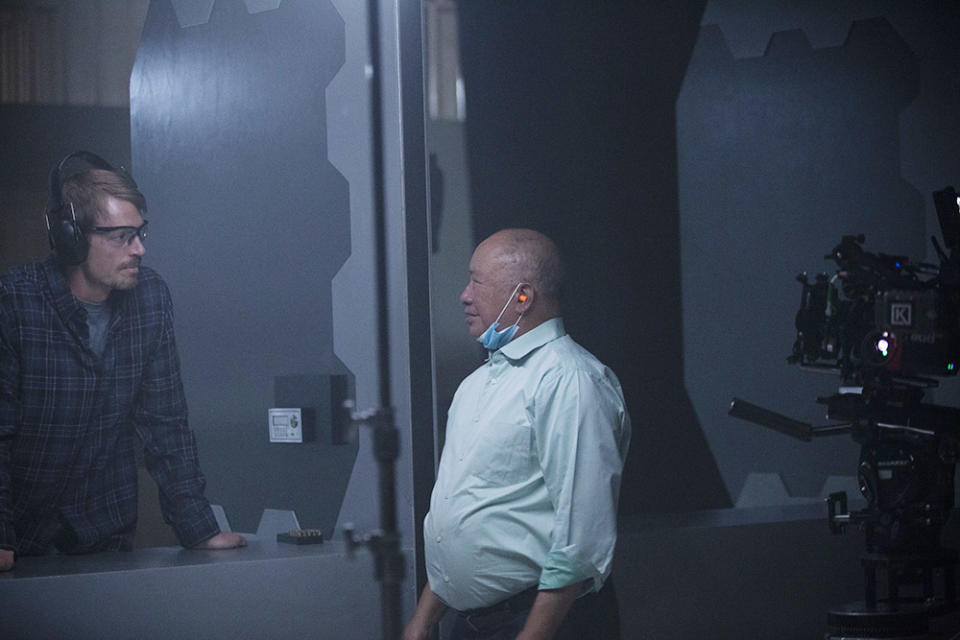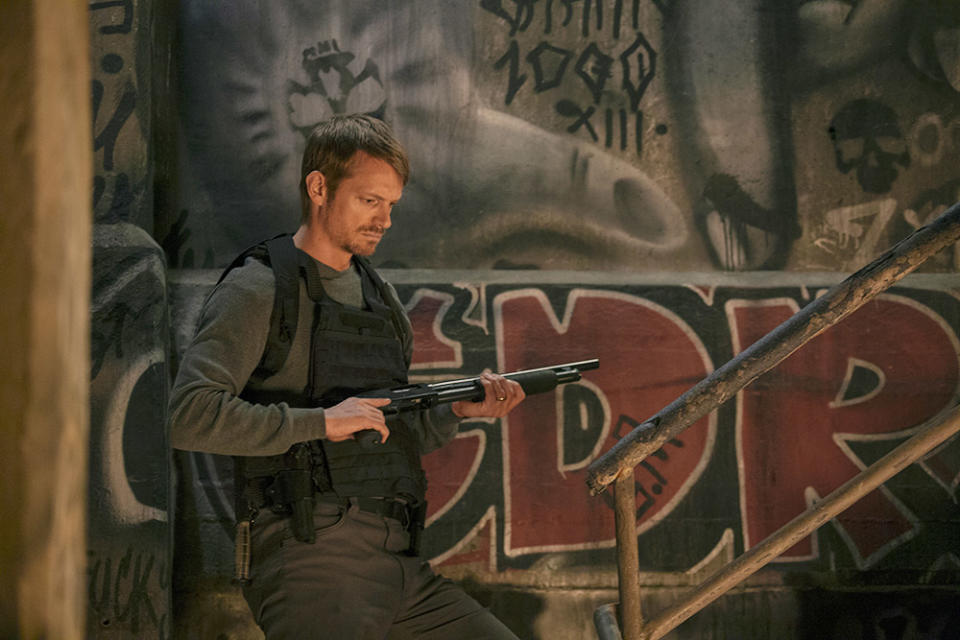‘Silent Night’ Director John Woo Explains Why He’s Dialed Back His Signature Action Style
- Oops!Something went wrong.Please try again later.
- Oops!Something went wrong.Please try again later.

From The Killer’s church shootout to Mission: Impossible 2’s motorcycle chase, John Woo’s over-the-top action style has been the stuff of legend for many decades, but now, at 77, the Hong Kong filmmaker has changed up his approach, beginning with the virtually dialogue-free revenge thriller Silent Night.
The Joel Kinnaman-led actioner is Woo’s first American film in two decades, an absence he chalks up to no longer being sent quality scripts. On its surface, Silent Night is a classic tale of vengeance, as Kinnaman’s Brian Godlock stops at nothing to avenge the gang-related death of his 7-year-old son. The quest is made all the more intriguing by Godlock’s inability to speak, having suffered a life-altering injury during his failed attempt to go after the offending gang in the immediate aftermath of his son’s death.
More from The Hollywood Reporter
'Silent Night' Review: Joel Kinnaman in John Woo's Gripping Hollywood Comeback
Joel Kinnaman Says He Tried Not Speaking for Two Months While Filming 'Silent Night'
Silent Night moviegoers are undoubtedly going to enjoy plenty of Woo-directed mayhem, but it’s a bit more restrained by his standards. The first half of the movie dives into Kinnaman’s character’s grief and DIY assassin training, which allows the second half’s bloodshed to be earned. Overall, Woo is now more interested in action from a character and dramatic standpoint rather than action for the sake of action.
“The biggest difference for me now is that the action should be realistic. It should serve the drama. In the past, my action was pretty much supposed to be entertaining,” Woo tells The Hollywood Reporter. “Silent Night’s action looks more realistic and more powerful, and it gives the audience more of a feeling instead of just being entertaining.”
Silent Night is another team-up between Lionsgate and producer Basil Iwanyk’s Thunder Road. The two companies are also responsible for the John Wick franchise, which proudly wears its John Woo influences on its sleeve. The filmmaker is delighted that a new generation of filmmakers borrow from him in the same way that he adopted the methods of Sam Peckinpah, Stanley Kubrick and Jean-Pierre Melville.
“It’s quite flattering. I appreciate it when I see some other young filmmakers take inspiration from my films, and it makes me feel happy. It is a nice thing not only culturally, but it shares good technique with each other. Some of them even work better than me, so I feel happy,” Woo says.
A sequel to one of Woo’s most beloved films, Face/Off, is currently in development from Adam Wingard and Simon Barrett, and it intends to somehow resume the story of Nicolas Cage and John Travolta’s characters. For Woo, he never imagined the Castor Troy (Cage) and Sean Archer (Travolta) story would ever continue. Instead, he preferred to take the premise elsewhere.
“I once thought that if I ever had a chance to make a Face/Off sequel, I would like it to star two female characters. Two women exchange faces to do something. So I suggested it to the studio, but they didn’t pay much attention to it,” Woo admits.
Below, during a recent conversation with THR, Woo also explains why he’s reimagining his celebrated 1989 film, The Killer, with a new take starring Nathalie Emmanuel and Omar Sy.
What made this the right time to come back to the States for the first time in two decades?
Well, 20 years ago, after I made Paycheck, I couldn’t get a better script. So I went back to China to make two or three big-budget movies, but it all didn’t work well. So that made me come back to America to take another try, and I got a script called Silent Night. I was so excited. It’s the kind of script I’d been looking for a long time. I’d been established as a big-budget director, and so they never sent me any good smaller-scale scripts. I’m also not American, so it is hard for me to make anything involved with American history. But when I came back here and read Silent Night, I was so excited by the real challenge of doing a movie without dialogue.
Had you wanted to try a dialogue-free action film for quite some time?
Yes, I’ve wanted to have less dialogue in an action movie. I always liked actors like Steve McQueen. They don’t say much, but they are powerful. So I was looking for that, but no dialogue was very new to me. I didn’t expect it. So the movie made me create a new technique to tell a story. The good thing about a movie without dialogue is that it allowed me to use the visuals and the sound to express myself and tell a much better story.
For a film with virtually no dialogue, how many pages did the script have?
Over 100 pages, just like a normal script.

Was there a moment from Joel Kinnaman’s past work that convinced you that he could carry this film non-verbally?
I don’t quite remember if there was one moment in particular, but he loved the challenge of this as well. He said that he’d love to work with me, and he’s just a real good actor. He’s a real actor. He’s not that superhero or super fighter type. He looks so real. And while we worked together, he came up with a lot of good ideas to help his performance. There’s a scene where his character finally walks into his [deceased] son’s room and sees his toys everywhere, and there was supposed to be a flashback of them playing with those toys. But then Joel came up to me and said, “What if I fall asleep and dream that I’m sleeping next to my son?” And I thought it was a really good idea. So we took out the flashback, and I created a shot of him falling asleep and then dreaming about having his son next to him. And when the camera pulls wide, the son disappears, and his character is emotional. I did it all in one take and Joel loved it. He’s so smart, and he was always giving me ideas because he was so drawn into the character.
Joel’s character does not begin the movie with the skills of an assassin. So he spends literally half the film training himself, and I admired that you didn’t cut any corners to get to the action sooner. Why was it important for you to earn the action from a character standpoint?
The action has to be for a reason. So I tried to make this movie more realistic, unlike what I have done before. My action is usually pretty over the top. Many people are killed, and the heroes are almost like superheroes. But I changed things here. Silent Night is a human story about an ordinary man seeking revenge against this huge gang. So he had to take quite some time to train himself and be good enough against all of those people, and you see all of that training in the last moments as he’s fighting all those guys. But the movie is about a father’s love for his son, so I didn’t let him do any action in the beginning.

You worked with a smaller budget than usual, which meant that you shot less coverage and found a different overall way to work. Did you end up enjoying this process? Do you think you’ll apply some of these methods going forward?
Yes, I enjoyed it a lot. We were short of time and money, so we had to shoot every single scene in a very smart and precise way to get what I needed. On big-budget Hollywood movies, I have a lot of time to set up different angles and shoot a lot of coverage, but with independent film, you have to work very carefully to shoot only the shot you really need. So it was a good experience for me. It also reminded me of old times in Hong Kong. It was a similar style, and we had a much smaller team that worked together. The director was everything, and there was no need to take any notes from anybody. We would just shoot scenes. Before we started shooting Silent Night, the producer, Basil Iwanyk, said, “The good thing about independent film is that you can have a lot of creative freedom.” And it was true. When I shot this movie, I didn’t get much interference from anybody.

Was the staircase oner the toughest challenge to pull off with the resources that you had?
Yes. I told our team that I wanted to do one shot of nonstop action where our hero is fighting from the first floor to the fourth floor, and they were all very excited. Even the cameraman was excited, and he had never used a Steadicam to do a whole scene like this before. Of course, we used some clever techniques to make it look like it was all in one shot. So I just wanted it to feel like he’s fighting in hell, and I think it worked pretty well.
What’s the biggest difference between the way you shoot action in 2023 versus 1993?
The biggest difference for me now is that the action should be realistic. It should serve the drama. In the past, my action was pretty much supposed to be entertaining. Silent Night’s action looks more realistic and more powerful, and it gives the audience more of a feeling instead of just being entertaining. [Akira] Kurosawa has said that if a fight scene is without the human element, then the action means nothing. So that’s what made me change and get more realistic.
Lionsgate and Basil Iwanyk’s Thunder Road are quite devoted to the action genre, and their John Wick franchise has your influence all over it. Is it flattering to see your impact on a new generation of filmmakers?
Yeah, it’s quite flattering. It makes me happy in a way, and I just feel like I’ve got so many friends. The good thing about filmmaking is that we are all learning from each other. In the old times, I learned so much from great filmmakers in the United States, France, Italy, Germany. So I have learned so much from the West, especially my idols Sam Peckinpah, Stanley Kubrick and Jean-Pierre Melville. I took so many good things from them, and then I used them to create my own style. So I appreciate it when I see some other young filmmakers take inspiration from my films, and it makes me feel happy. It is a nice thing not only culturally, but it shares good technique with each other. Some of them even work better than me, so I feel happy.
I spoke to Charles Roven not too long ago, and we talked about your new take on your 1989 classic, The Killer. What made you want to reimagine your own film?
Well, the project was in the works for many years, but it was hard to find a director to direct it. So when I came back [to the States], we got support from Universal, and they asked me to do it. So I decided to give it a try, and we have a very good script from Brian Helgeland. He’s so wonderful, and he wrote the new movie to look so much different from my work. It looks like another movie, not mine. So I took the job and we’ll see how it works.
A Face/Off sequel is in some stage of development. Did you ever envision that story continuing?
No. I once thought that if I ever had a chance to make a Face/Off sequel, I would like it to star two female characters. Two women exchange faces to do something. So I suggested it to the studio, but they didn’t pay much attention to it.
John Woo, it was an honor to talk to you, and thank you for all the entertainment over the years.
It’s my honor, and thank you for your support and friendship.
***
Silent Night is now playing in movie theaters. This interview was edited for length and clarity.
Best of The Hollywood Reporter
Martin Scorsese’s 10 Best Movies Ranked, Including 'Killers of the Flower Moon'
13 Times Hollywood Predicted the Scary (or Not So Scary) Future of AI

